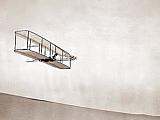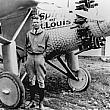
Learning to Fly
November 7th, 2012
Daring young men, eager to emulate the birds, experimented with gliders and heavier-than-air planes as they attempted to escape earth's gravity.
Transcript
Harold and Royal Thorndill appear to be the first in Grand Rapids who experimented with gliders. Their field was a hill east of Fuller and north of Michigan. Reportedly they made numerous small jumps over a period of three years around 1906.
John Paul Jones and Louis Clark rigged up a glider from split bamboo covered with Japanese silk in 1910. Jones made the test flights from the old brickyard near Michigan and Fuller. It is claimed he soared about 1,000 feet, followed by a perfect landing. Then Jones decided to attach a bicycle to the undercarriage of the glider believing that a faster takeoff would increase the flight distance. The bicycle broke loose on takeoff, but only Jones’ dignity was injured.
That same year, Irving Bissell and Francis Mason, an engineer at the Bissell plant, built the first heavier-than-air plane, which used a 30 horsepower motor. One of its novel features lay in the lateral controls. Instead of ailerons, tilting propellers were used on the wing tips. These revolving propellers, when tilted up or down were used to push the wings up or down.
Arthur Rosenthal and his partner, Frank Lemon, volunteered to fly the Bissell-Mason plane. The first attempted flights were from a field on the old Bonnell farm in East Grand Rapids. The following winter Lemon made numerous “hops” from the ice on Reed’s Lake, but the craft was underpowered and never flew more than a few feet.
Full Details
| Title | Learning to Fly |
|---|---|
| Creator | |
| Keywords | WYCE; radio; Grand Rapids; Historical Commission; history; gliders; airplanes; Reed's Lake |
| Duration | 2:12 |
| Pubdate String | November 7th, 2012 |

 facebook
facebook